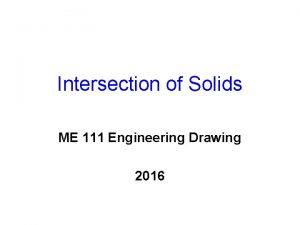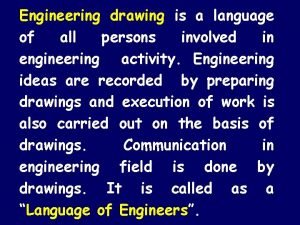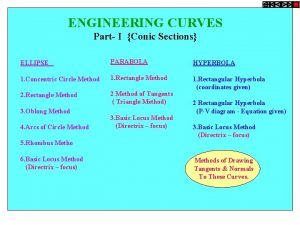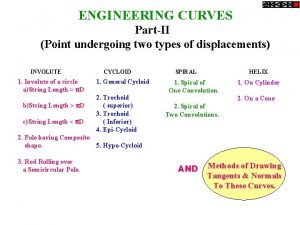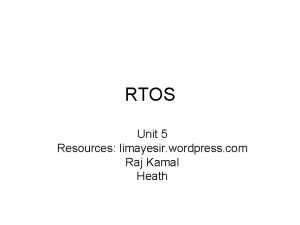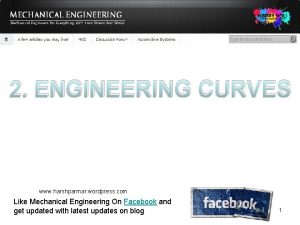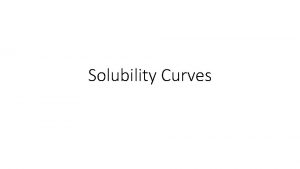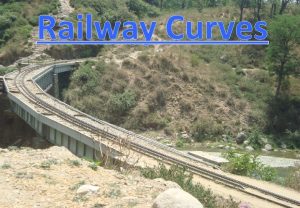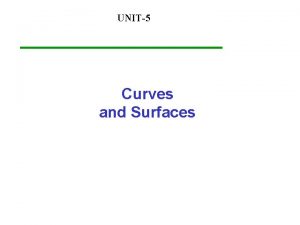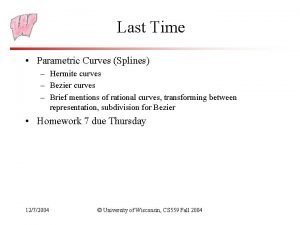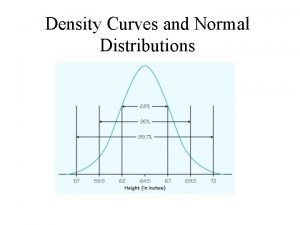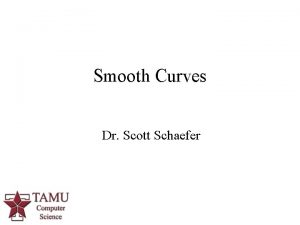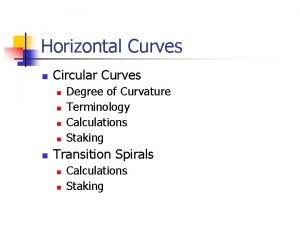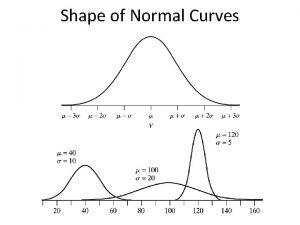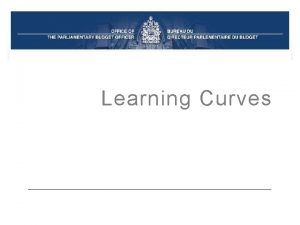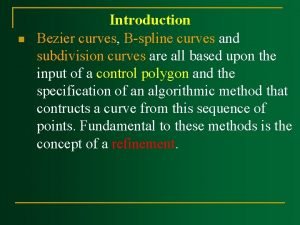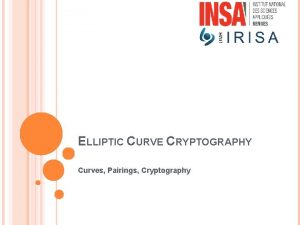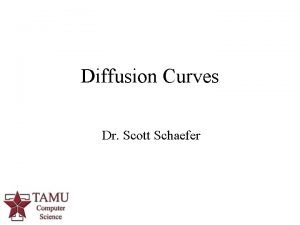1 ENGINEERING CURVES www harshparmar wordpress com Like





















- Slides: 21

1. ENGINEERING CURVES www. harshparmar. wordpress. com Like Mechanical Engineering On Facebook and get updated with latest updates on blog

ENGINEERING CURVES Part- I {Conic Sections} ELLIPSE PARABOLA HYPERBOLA 1. Concentric Circle Method 1. Rectangle Method 2 Method of Tangents ( Triangle Method) 1. Rectangular Hyperbola (coordinates given) 3. Oblong Method 4. Arcs of Circle Method 3. Basic Locus Method (Directrix – focus) 2 Rectangular Hyperbola (P-V diagram - Equation given) 3. Basic Locus Method (Directrix – focus) 5. Rhombus Metho 6. Basic Locus Method (Directrix – focus) Methods of Drawing Tangents & Normals To These Curves. www. harshparmar. wordpress. com 2

CONIC SECTIONS ELLIPSE, PARABOLA AND HYPERBOLA ARE CALLED CONIC SECTIONS BECAUSE THESE CURVES APPEAR ON THE SURFACE OF A CONE WHEN IT IS CUT BY SOME TYPICAL CUTTING PLANES. OBSERVE ILLUSTRATIONS GIVEN BELOW. . Section Plane Through Generators Par abo la Ellipse Section Plane Parallel to end generator. www. harshparmar. wordpress. com Section Plane Parallel to Axis. Hyperbola 3

COMMON DEFINATION OF ELLIPSE, PARABOLA & HYPERBOLA: These are the loci of points moving in a plane such that the ratio of it’s distances from a fixed point And a fixed line always remains constant. The Ratio is called ECCENTRICITY. (E) A) For Ellipse E<1 B) For Parabola E=1 C) For Hyperbola E>1 Refer Problem nos. 6. 9 & 12 SECOND DEFINATION OF AN ELLIPSE: It is a locus of a point moving in a plane such that the SUM of it’s distances from TWO fixed points always remains constant. {And this sum equals to the length of major axis. } These TWO fixed points are FOCUS 1 & FOCUS 2 Refer Problem no. 4 www. harshparmar. wordpress. com Ellipse by Arcs of Circles Method. 4

ELLIPSE BY CONCENTRIC CIRCLE METHOD Problem 1 : Draw ellipse by concentric circle method. Take major axis 100 mm and minor axis 70 mm long. 3 2 Steps: 1. Draw both axes as perpendicular bisectors of each other & name their ends as shown. 2. Taking their intersecting point as a center, draw two concentric circles considering both as respective diameters. 3. Divide both circles in 12 equal parts & name as shown. 4. From all points of outer circle draw vertical lines downwards and upwards respectively. 5. From all points of inner circle draw horizontal lines to intersect those vertical lines. 6. Mark all intersecting points properly as those are the points on ellipse. 7. Join all these points along with the ends of both axes in smooth possible curve. It is required ellipse. 4 C 1 2 3 5 4 1 5 A B 10 10 6 9 8 D 9 7 6 7 8 www. harshparmar. wordpress. com 5

Steps: 1 Draw a rectangle taking major and minor axes as sides. 2. In this rectangle draw both axes as perpendicular bisectors of each other. . 3. For construction, select upper left part of rectangle. Divide vertical small side and horizontal long side into same number of equal parts. ( here divided in four parts) 4. Name those as shown. . 5. Now join all vertical points 1, 2, 3, 4, to the upper end of minor axis. And all horizontal points i. e. 1, 2, 3, 4 to the lower end of minor axis. 6. Then extend C-1 line upto D-1 and mark that point. Similarly extend C-2, C-3, C-4 lines up to D-2, D-3, & D-4 lines. 7. Mark all these points properly and join all along with ends A and D in smooth possible curve. Do similar construction in right side part. along with lower half of the rectangle. Join all points in smooth curve. It is required ellipse. ELLIPSE BY RECTANGLE METHOD Problem 2 Draw ellipse by Rectangle method. Take major axis 100 mm and minor axis 70 mm long. D 4 4 3 3 2 2 1 1 A 1 2 3 4 3 2 B 1 C www. harshparmar. wordpress. com 6

Problem 3: Draw ellipse by Oblong method. Draw a parallelogram of 100 mm and 70 mm long sides with included angle of 750. Inscribe Ellipse in it. ELLIPSE BY OBLONG METHOD STEPS ARE SIMILAR TO THE PREVIOUS CASE (RECTANGLE METHOD) ONLY IN PLACE OF RECTANGLE, HERE IS A PARALLELOGRAM. D 4 4 3 3 2 2 1 1 A www. harshparmar. wordpress. com 1 2 3 C 4 3 2 1 B 7

ELLIPSE PROBLEM 4. MAJOR AXIS AB & MINOR AXIS CD ARE 100 AMD 70 MM LONG RESPECTIVELY. DRAW ELLIPSE BY ARCS OF CIRLES METHOD. STEPS: 1. Draw both axes as usual. Name the ends & intersecting point 2. Taking AO distance I. e. half major axis, from C, mark F 1 & F 2 On AB . ( focus 1 and 2. ) 3. On line F 1 - O taking any distance, mark points 1, 2, 3, & 4 4. Taking F 1 center, with distance A-1 draw an arc above AB and taking F 2 center, with B-1 distance cut this arc. Name the point p 1 5. Repeat this step with same centers but A taking now A-2 & B-2 distances for drawing arcs. Name the point p 2 6. Similarly get all other P points. With same steps positions of P can be located below AB. 7. Join all points by smooth curve to get an ellipse/ BY ARCS OF CIRCLE METHOD As per the definition Ellipse is locus of point P moving in a plane such that the SUM of it’s distances from two fixed points (F 1 & F 2) remains constant and equals to the length of major axis AB. (Note A. 1+ B. 1=A. 2 + B. 2 = AB) p 3 p 4 C p 2 p 1 F 1 1 2 3 4 O B F 2 D www. harshparmar. wordpress. com 8

ELLIPSE PROBLEM 5. DRAW RHOMBUS OF 100 MM & 70 MM LONG DIAGONALS AND INSCRIBE AN ELLIPSE IN IT. STEPS: 1. Draw rhombus of given dimensions. 2. Mark mid points of all sides & name Those A, B, C, & D 3. Join these points to the ends of smaller diagonals. 4. Mark points 1, 2, 3, 4 as four centers. 5. Taking 1 as center and 1 -A radius draw an arc AB. 6. Take 2 as center draw an arc CD. 7. Similarly taking 3 & 4 as centers and 3 -D radius draw arcs DA & BC. BY RHOMBUS METHOD 2 A B 4 3 C D 1 www. harshparmar. wordpress. com 9

ELLIPSE PROBLEM 6: - POINT F IS 50 MM FROM A LINE AB. A POINT P IS MOVING IN A PLANE SUCH THAT THE RATIO OF IT’S DISTANCES FROM F AND LINE AB REMAINS CONSTANT DIRECTRIX-FOCUS METHOD AND EQUALS TO 2/3 DRAW LOCUS OF POINT P. { ECCENTRICITY = 2/3 } DIRECTRIX A 45 mm 30 mm STEPS: 1. Draw a vertical line AB and point F 50 mm from it. 2. Divide 50 mm distance in 5 parts. 3. Name 2 nd part from F as V. It is 20 mm and 30 mm from F and AB line resp. It is first point giving ratio of it’s distances from F and AB 2/3 i. e 20/30 4 Form more points giving same ratio such as 30/45, 40/60, 50/75 etc. 5. Taking 45, 60 and 75 mm distances from line AB, draw three vertical lines to the right side of it. 6. Now with 30, 40 and 50 mm distances in compass cut these lines above and below, with F as center. 7. Join these points through V in smooth curve. This is required locus of P. It is an ELLIPSE (vertex) V F ( focus) B www. harshparmar. wordpress. com 10

PARABOLA RECTANGLE METHOD PROBLEM 7: A BALL THROWN IN AIR ATTAINS 100 M HIEGHT AND COVERS HORIZONTAL DISTANCE 150 M ON GROUND. Draw the path of the ball (projectile)- STEPS: 1. Draw rectangle of above size and divide it in two equal vertical parts 2. Consider left part for construction. Divide height and length in equal number of parts and name those 1, 2, 3, 4, 5& 6 3. Join vertical 1, 2, 3, 4, 5 & 6 to the top center of rectangle 4. Similarly draw upward vertical lines from horizontal 1, 2, 3, 4, 5 And wherever these lines intersect previously drawn inclined lines in sequence Mark those points and further join in smooth possible curve. 5. Repeat the construction on right side rectangle also. Join all in sequence. This locus is Parabola. . 6 6 5 5 4 4 3 3 2 2 1 1 1 www. harshparmar. wordpress. com 2 3 4 5 6 5 4 3 2 1 11

Draw a parabola by tangent method given base 7. 5 m and axis 4. 5 m Take scale 1 cm = 0. 5 m O 6 5 1’ 4. 5 m 4 3 2’ F 3’ 2 4’ 4. 5 m 1 5’ 6’ A www. harshparmar. wordpress. com E 7. 5 m B 12

PARABOLA PROBLEM 9: Point F is 50 mm from a vertical straight line AB. Draw locus of point P, moving in a plane such that it always remains equidistant from point F and line AB. SOLUTION STEPS: 1. Locate center of line, perpendicular to AB from point F. This will be initial point P and also the vertex. 2. Mark 5 mm distance to its right side, name those points 1, 2, 3, 4 and from those draw lines parallel to AB. 3. Mark 5 mm distance to its left of P and name it 1. 4. Take O-1 distance as radius and F as center draw an arc cutting first parallel line to AB. Name upper point P 1 and lower point P 2. (FP 1=O 1) 5. Similarly repeat this process by taking again 5 mm to right and left and locate P 3 P 4. 6. Join all these points in smooth curve. DIRECTRIX-FOCUS METHOD PARABOLA A P 1 O (VERTEX) V 1 2 3 4 F ( focus) P 2 B It will be the locus of P equidistance from line AB and fixed point F. www. harshparmar. wordpress. com 13

HYPERBOLA Problem No. 10: Point P is 40 mm and 30 mm from horizontal and vertical axes respectively. Draw Hyperbola through it. THROUGH A POINT OF KNOWN CO-ORDINATES Solution Steps: 1) Extend horizontal line from P to right side. 2) Extend vertical line from P upward. 3) On horizontal line from P, mark some points taking any distance and name them after P-1, 2, 3, 4 etc. 4) Join 1 -2 -3 -4 points to pole O. Let them cut part [P-B] also at 1, 2, 3, 4 points. 5) From horizontal 1, 2, 3, 4 draw vertical lines downwards and 6) From vertical 1, 2, 3, 4 points [from P-B] draw horizontal lines. 40 mm 7) Line from 1 horizontal and line from 1 vertical will meet at P 1. Similarly mark P 2, P 3, P 4 points. 8) Repeat the procedure by marking four points on upward vertical line from P and joining all those to pole O. Name this points P 6, P 7, P 8 etc. and join them by smooth curve. 2 1 P 1 2 3 O 30 mm www. harshparmar. wordpress. com 14

HYPERBOLA P-V DIAGRAM Problem no. 11: A sample of gas is expanded in a cylinder from 10 unit pressure to 1 unit pressure. Expansion follows law PV=Constant. If initial volume being 1 unit, draw the curve of expansion. Also Name the curve. 10 Form a table giving few more values of P & V 9 10 5 4 2. 5 2 1 1 = 2. 5 = 4 = 5 = 10 10 Now draw a Graph of Pressure against Volume. It is a PV Diagram and it is Hyperbola. Take pressure on vertical axis and Volume on horizontal axis. 8 7 6 PRESSURE ( Kg/cm 2) +++ + P V = C 5 4 3 2 1 0 1 2 3 4 5 6 7 8 10 9 VOLUME: ( M 3 ) www. harshparmar. wordpress. com 15

PROBLEM 12: - POINT F IS 50 MM FROM A LINE AB. A POINT P IS MOVING IN A PLANE SUCH THAT THE RATIO OF IT’S DISTANCES FROM F AND LINE AB REMAINS CONSTANT AND EQUALS TO 2/3 DRAW LOCUS OF POINT P. { ECCENTRICITY = 2/3 } A 30 mm 45 m m STEPS: 1. Draw a vertical line AB and point F 50 mm from it. 2. Divide 50 mm distance in 5 parts. 3. Name 2 nd part from F as V. It is 20 mm and 30 mm from F and AB line resp. It is first point giving ratio of it’s distances from F and AB 2/3 i. e 20/30 4 Form more points giving same ratio such as 30/45, 40/60, 50/75 etc. 5. Taking 45, 60 and 75 mm distances from line AB, draw three vertical lines to the right side of it. 6. Now with 30, 40 and 50 mm distances in compass cut these lines above and below, with F as center. 7. Join these points through V in smooth curve. This is required locus of P. It is an ELLIPSE. HYPERBOLA DIRECTRIX FOCUS METHOD (vertex) V F ( focus) B www. harshparmar. wordpress. com 16

ELLIPSE TANGENT & NORMAL Problem 13: TO DRAW TANGENT & NORMAL TO THE CURVE FROM A GIVEN POINT ( Q ) p 4 p 3 C p 2 p 1 F 1 1 2 3 4 O B F 2 MA L A NOR 3. 1. JOIN POINT Q TO F 1 & F 2 2. BISECT ANGLE F 1 Q F 2 THE ANGLE BISECTOR IS NORMAL A PERPENDICULAR LINE DRAWN TO IT IS TANGENT TO THE CURVE. Q TAN GE NT D www. harshparmar. wordpress. com 17

ELLIPSE TANGENT & NORMAL Problem 14: 1. JOIN POINT Q TO F. 2. CONSTRUCT 900 ANGLE WITH THIS LINE AT POINT F 3. EXTEND THE LINE TO MEET DIRECTRIX AT T 4. JOIN THIS POINT TO Q AND EXTEND. THIS IS TANGENT TO ELLIPSE FROM Q 5. TO THIS TANGENT DRAW PERPENDICULAR LINE FROM Q. IT IS NORMAL TO CURVE. ELLIPSE A DIRECTRIX TO DRAW TANGENT & NORMAL TO THE CURVE FROM A GIVEN POINT ( Q ) T (vertex) V F ( focus) 900 N N Q B www. harshparmar. wordpress. com T 18

PARABOLA TANGENT & NORMAL Problem 15: TO DRAW TANGENT & NORMAL TO THE CURVE FROM A GIVEN POINT ( Q ) T PARABOLA A 1. JOIN POINT Q TO F. 2. CONSTRUCT 900 ANGLE WITH THIS LINE AT POINT F 3. EXTEND THE LINE TO MEET DIRECTRIX AT T 4. JOIN THIS POINT TO Q AND EXTEND. THIS IS TANGENT TO THE CURVE FROM Q 5. TO THIS TANGENT DRAW PERPENDICULAR LINE FROM Q. IT IS NORMAL TO CURVE. VERTEX V 900 F ( focus) N Q B N T www. harshparmar. wordpress. com 19

HYPERBOLA TANGENT & NORMAL Problem 16 TO DRAW TANGENT & NORMAL TO THE CURVE FROM A GIVEN POINT ( Q ) 1. JOIN POINT Q TO F. 2. CONSTRUCT 900 ANGLE WITH THIS LINE AT POINT F 3. EXTEND THE LINE TO MEET DIRECTRIX AT T 4. JOIN THIS POINT TO Q AND EXTEND. THIS IS TANGENT TO CURVE FROM Q 5. TO THIS TANGENT DRAW PERPENDICULAR LINE FROM Q. IT IS NORMAL TO CURVE. A T (vertex) F ( focus) V 900 N N Q B www. harshparmar. wordpress. com T 20

THANKS. . www. harshparmar. wordpress. com Like Mechanical Engineering On Facebook and get updated with latest updates on blog
 Bài thơ mẹ đi làm từ sáng sớm
Bài thơ mẹ đi làm từ sáng sớm Cơm
Cơm Intersection of two cylinders engineering drawing
Intersection of two cylinders engineering drawing Define hyperbola in engineering drawing
Define hyperbola in engineering drawing Is cycloid a conic section
Is cycloid a conic section How to draw tangent and normal to cycloid
How to draw tangent and normal to cycloid Engineering curves
Engineering curves Cvorovic mirjana wordpress
Cvorovic mirjana wordpress O evangelho segundo o espiritismo wordpress
O evangelho segundo o espiritismo wordpress Wordpress deployment automation
Wordpress deployment automation Seo aachen wordpress
Seo aachen wordpress Plone vs joomla
Plone vs joomla Rtos
Rtos Kiedrowski plan nawozowy 2021
Kiedrowski plan nawozowy 2021 Saurabh maru wordpress
Saurabh maru wordpress Blogspot
Blogspot Cvorovic mirjana wordpress
Cvorovic mirjana wordpress Cara install wordpress di localhost
Cara install wordpress di localhost Muqith wordpress grade 8
Muqith wordpress grade 8 Floresta nacional de ipanema
Floresta nacional de ipanema Geografija 2015 wordpress
Geografija 2015 wordpress Www.matheportal.wordpress.com
Www.matheportal.wordpress.com


